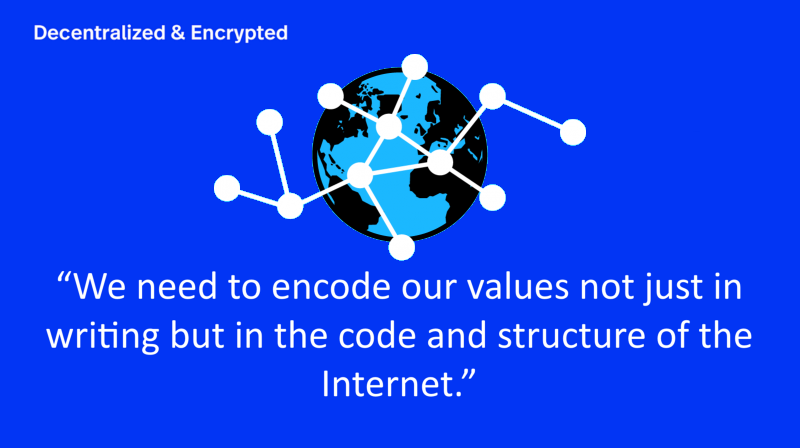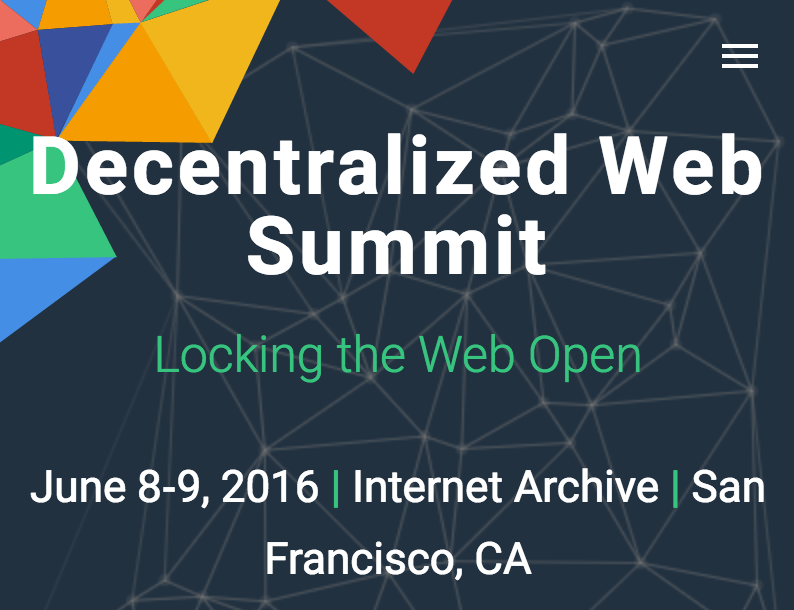The DEvolution of the Internet
The Decentralized Web Summit, From Centralized to Decentralized

The roots of the Internet is decentralized design, which have been forgotten over the years. But some pioneers and innovators of right now, are reclaiming its roots. In the Decentralization Movement of everything digital.
Why Decentralized? The Internet is fragile. It is not universally accessible. It is too easy for centralized entities to censor connections, controlling what people can and cannot view on the Web. With the Edward J. Snowden revelations; that the web has been used by governments for spying and the realization that companies like Amazon, Facebook and Google have become gatekeepers to our digital lives have added to concerns. A Decentralized Web can address all of these problems by building in security, privacy, and preservation by default, ensuring that websites are easily accessible to all as long as at least one person somewhere in the world is hosting a copy.
The first Decentralized Web Summit was held June 8‐9, 2016, at Internet Archive San Francisco, CA “Locking the Web Open”.
The Summit’s Call to Action; “ The current Web is not private or censorship-free. It lacks a memory, a way to preserve our culture’s digital record through time. The Decentralized Web aims to make the Web open, secure and free of censorship by distributing data, processing, and hosting across millions of computers around the world, with no centralized control.”
The Summit was a two-day event for high level discussions among pioneers and innovators from around the globe working on decentralized technologies. What decentralized apps are being built today, and what is just on the horizon? Can we prototype the Decentralized Web and start to lock the Web open for good?

The day started with a kickoff by Mitchell Baker, Executive Chairperson of the Mozilla Foundation. She emphasized that when we think about what principles we want to embody in technology for that will support a decentralized web. She suggested four principles: immediacy; safely access content, openness; “One relationship that matters, and that’s between the human being and the publisher of the content,”, universality; that content should run on any platform, and agency; “The content provider doesn’t have 100% of the power — there is technology and policy that helps you mediate that experience”.
In a Panel with Amber Case, Primavera De Filippi, Max Ogden, Wendy Seltzer. Topic was “As we build a Decentralized Web, what values do we want written in the code?”
It’s easy as engineers to concentrate on the code and not on those we are building for. What are the values we should be trying to embed in the code? What are the principles we can agree upon about the way this Web should be governed?
A clip from the Panel
The Summit ended with a Panel that tried to answer the question “Can we prototype the Decentralized Web and start to lock the Web open for good?”
Panel — Moonshot Challenge — What could you do to Decentralize Scientific Journal Articles? Wendy Hanamura, moderator, Juan Benet, Trent McConaghy, Karissa McKelvey, Denis Nazarov, Evan Schwartz.
In this panel, they presented the new “moonshot” challenge: Can we Lock Open the Internet for good?
Each member of the Panel worked on a piece to this puzzle, basically coming up “Whole Package of Decentralized Internet”; Juan Benet — The InterPlanetary File System: hypermedia distribution protocol addressed by content and identities, Trent McConaghy — BigchainDB: scalable blockchain database, Evan Schwartz — Interledger: protocol for connecting ledgers, Denis Nazarov — Mediachain: a distributed metadata protocol, Karissa McKelvey — Dat: an open source, decentralized data tool for distributing datasets small and large.
A clip from the Panel
IPFS: the InterPlanetary File System
Is a new hypermedia distribution protocol, addressed by content and identities. IPFS enables the creation of completely distributed applications. It aims to make the web faster, safer, and more open.
IPFS is a distributed file system that seeks to connect all computing devices with the same system of files. IPFS is actually more similar to a single bittorrent swarm exchanging git objects.
IPFS is becoming a new major subsystem of the internet. It could complement or replace HTTP. It could complement or replace even more. It sounds crazy. It is crazy. You can read more about its origins in the paper IPFS — Content Addressed, Versioned, P2P File System.
BigchainDB: A Scalable Blockchain Database
The BigchainDB design starts with a distributed database (DB), and through a set of innovations adds blockchain characteristics: decentralized control, immutability, and creation & movement of digital assets. BigchainDB inherits characteristics of modern distributed databases: linear scaling in throughput and capacity with the number of nodes, a full-featured NoSQL query language, efficient querying, and permissioning.
Scalable capacity means that legally binding contracts and certificates may be stored directly on the blockchain database. The permissioning system enables configurations ranging from private enterprise blockchain databases to open, public blockchain databases. BigchainDB is complementary to decentralized processing platforms like Ethereum, and decentralized file systems like InterPlanetary File System (IPFS). Read more about it in the paper:BigchainDB: A Scalable Blockchain Database.
Interledger: Protocol for Connecting Ledgers
Interledger is protocols for connecting ledgers of all types: from digital wallets and national payment systems to blockchains and more. This will make it easy to transact with anyone, no matter where we live or what type of money we use. Sending value will be as easy as sending email is today. This is the vision of the Internet of Value.
Learn more about Interledger: Why Interledger?
Mediachain: A Distributed Metadata Protocol
Mediachain; An open, universal media library, that automatically connects media to its creator and information about it.Shifting the balance of network effects with decentralized, open data. Read More about it in its blog:Introducing Mediachain.
Dat: An Open Decentralized Data Tool for Distributing Datasets
Dat is an open source, decentralized data tool for distributing datasets small and large. It can be used to version data locally, or to share and sync data over the internet. Dat includes an optional peer-to-peer distribution system, meaning that the more widely that a dataset is shared, the faster it is for users to retrieve or sync a copy, and the more redundant that the dataset’s availability becomes.
To Learn More: About Dat.

- Decentralized Web Summit: Locking the Web Open
- Locking the Web Open: Dispatches from Morning One of the Decentralized Web Summit
- Values, Governance, and What Comes Next: Afternoon Sessions at the Decentralized Web Summit
- The Web’s Creator Looks to Reinvent It
Connect Wallet
To earn tokens and access the decentralized web, select an option below
(It's easier than you think)